Fighting the Flames
Fire Supression Systems for Motorhomes
Article Date: September, 2010
Article and Photography by Mark Quasius
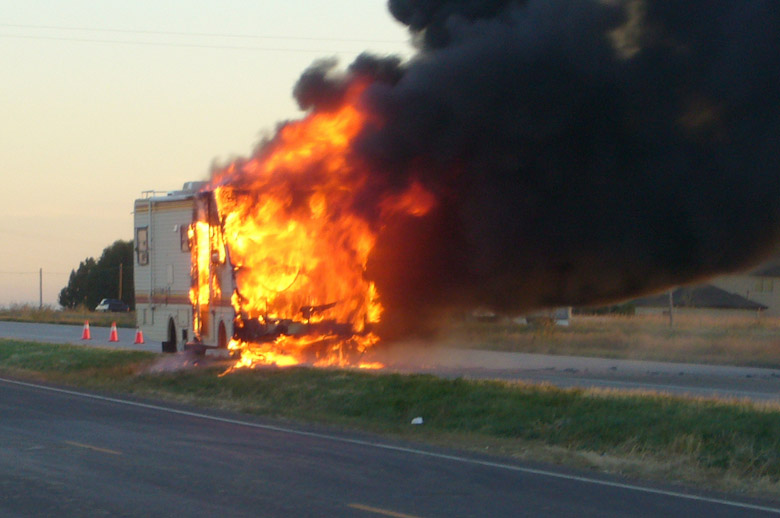
As disastrous as it can be, an RV fire doesn't have to happen if you plan ahead. But if a fire begins in a
motorhome, it won't take much time until the RV is totally consumed in flames, unless you take some precautions.
Your typical motorhome is constructed from highly flammable materials. Add in the fact that your motorhome
carries propane plus either gasoline or diesel fuel, throw in a maze of electrical systems and wiring and then bounce it down the
road until something fails, and you quickly realize that there is a fair amount of potential for a fire to start.
Most RV fires begin in one of two areas: Typical RV refrigerators utilize evaporative cooling, which utilize
a propane burner or electric element to provide that heat. If the propane burner on the back of the refrigerator overheats it can
easily start a fire.
On a rear-engine diesel pusher there is also the potential for an engine bay fire. Diesel engines are
turbocharged and the turbocharger gets very hot during operation, especially when climbing grades. If a hydraulic line or fuel
line were to leak, it can easily spray fuel over the engine compartment. Once ignited by the hot turbocharger, it can quickly
get out of control.
RVs are equipped with a fire extinguisher, per NFPA code. However, these only meet the minimum requirements
set by law. It has no bearing on its ability to adequately extinguish a fire in your RV. It's generally undersized and not up to
the task.
There are many classes of fires, and not all extinguishers are rated for every classification. Before we can
understand the various types of fire extinguishers, we first need to understand fire itself. To do this we'll take a look at the
fire triangle, which is used to help illustrate the basic elements present in a fire.
|
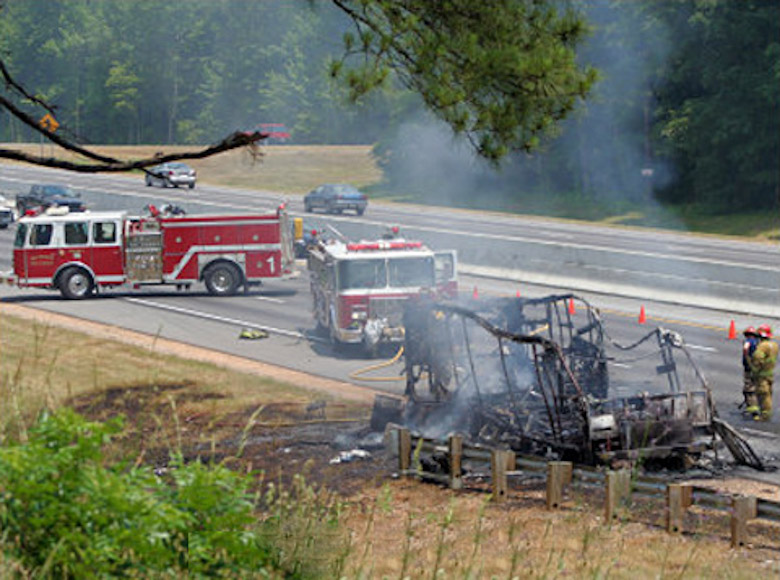
A motorhome fire quickly consumes the RV if not stopped immediately.
|

The Fire Triangle shows the three elements that are present in any fire. Remove any one element to
extinguish the fire.
|
A fire is actually a rapid chemical reaction. In order to begin, or sustain, that reaction, you need to have
three key elements present: fuel, oxygen, and heat. If you remove any one of these elements, fire cannot be sustained. In order
to extinguish a fire, you must be able to eliminate at least one of these elements.
Fuel, Oxygen and Heat
In an RV there's an overabundance of fuel. RVs are made with a large amount of wood and composite materials
and use extensive amounts of glues and insulating foams. In addition, there's plenty of wiring, which has burnable insulation, as
well as propane and gasoline or diesel fuel present. The interior furniture, bedding, drapery, carpeting, all combine to assist a
fire and let it spread rapidly. You need oxygen to have fire too. It's everpresent in and around the RV.
Then these combustible materials only need to be raised to their combustible temperature and ignition will
occur. An electrical short creates intense heat in the wire. Generally this wiring is run through or around highly combustible
materials, such as wood paneling, carpeting, etc. A hot wire can easily cause any one of these fuels to ignite.
Class-A Fires
Class-A fires are created from solid combustible fuels (other than metals). Examples of this are wood, paper,
cloth, and plastics. Class-A fires leave ash, so think of the word "ash" to help remember what an "A" fire is.
To extinguish a Class-A fire, you can either separate it from its oxygen or cool it down below its flash point.
This is the easiest fire to put out, and plain water works. Ideally you'd add an element to the water (soap works) to break the surface
tension and separate the fuel from its oxygen, allowing the water to further cool down the fuel.
Class-B Fires
Class-B fires are fires from flammable liquids. Examples of this are gasoline, oil, grease, diesel fuel, and
alcohol. Liquids boil, so think of the word "boil" to remember what Class "B" fires are. These fires don't get extinguished with just
plain water. The fuel floats on the surface of the water and tends to spread to other areas, which only makes the situation worse.
Class-C Fires
Class-C fires are electrical fires caused by energized circuits. If it's plugged in, consider it a Class-C fire.
Note that the wire itself doesn't burn-it's the insulation and any surrounding components. Once the circuit is de-energized, you can
treat it as a Class-A fire. The Class-C designation only describes energized circuits, where water-type extinguishers could create an
electrical shock hazard. Electrical wires conduct current, so associate the word "current" with a Class "C" fire.
Class-D Fires
Class-D fires are fires from burning metal. Not too many metals burn, but certain metals, such as magnesium,
potassium, and sodium can. You aren't apt to find these kinds of fires in an RV, so we won't get into them. If you do run across this
kind of fire, they are next to impossible to extinguish.
Fire Extinguisher Types
Fire extinguishers come in many types and sizes, just like fires. There are a wide variety of extinguishers,
each designed for a specific application. Following is a brief description of the various types of extinguishers and fire fighting
agents used in them.
|

Dry chemical extinguishers need to be regularly serviced to maintain pressure and prevent packing.
|
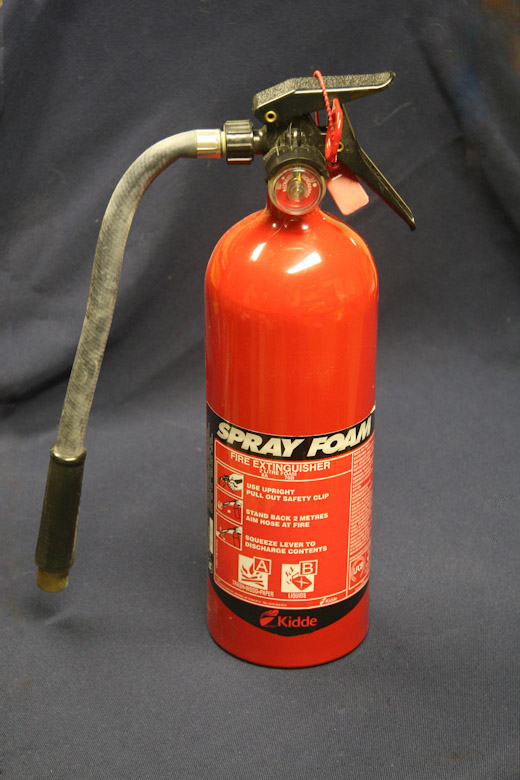
AFFF Foam extinguisher do a better job of protecting an RV.
|
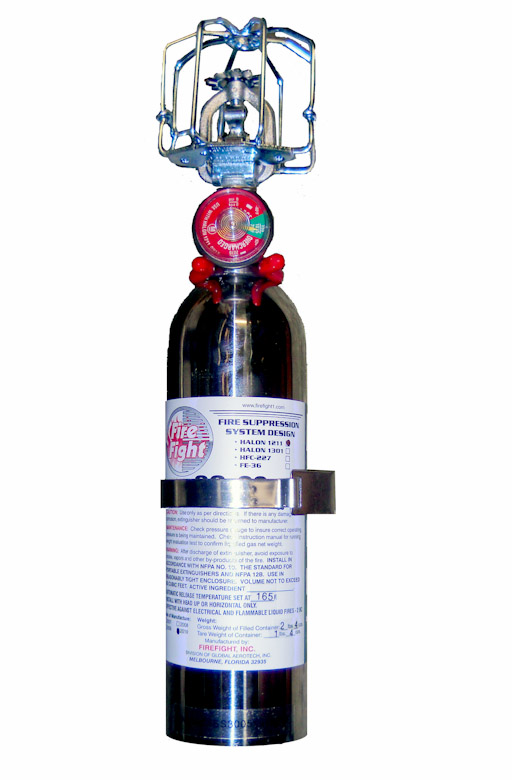
Autometic Clean Agent Gas extinguishers work well for protecting confined areas, such
as behind refrigerators.
|
Air Pressurized Water (APW) extinguishers are large tanks that are filled about two-thirds of the way with
water. They are then pressurized with compressed air. When the trigger is pulled, the water exits out of the hose and nozzle like a
giant squirt gun.
APWs are used to extinguish Class-A fires by taking away the heat portion of the fire triangle. If you use
them on a Class-B fire, the water will spread the burning liquid farther and create an even larger situation. They also cannot be
used on electrical circuits unless the power has been killed or else they can conduct electricity and create an electrical shock
hazard. APW extinguishers are rated for Class-A fires.
Carbon dioxide (CO2) extinguishers are filled with CO2 gas that is compressed to a very high pressure. They
use a hard plastic horn rather than a hose with nozzle. The CO2 exits at very high pressure and frost, which is actually dry ice, may
form on the horn as well as on surrounding materials. CO2 extinguishers are rated for use on Class-B and -C fires. They operate by
displacing oxygen from the fire, effectively suffocating the fire. A side benefit is that the CO2 is cold due to its high exit
velocity, so it also helps cool the fire. CO2 is generally not effective on Class-A fires because they may not displace enough
oxygen to effectively smother it and prevent it from re-igniting. Most CO2 extinguishers are rated for Class-A, -B, and -C fires.
The most popular fire extinguishers available for consumer use today are the dry chemical variety. The dry
chemical, which resembles baking soda, is a fine powder that fills the extinguisher and is pressurized with nitrogen. The biggest
reason for their popularity is you can use them on Class-A, -B, and -C fires, which makes them fairly universal. They function by
coating the fuel with a fine layer of chemical to separate the fuel from the oxygen in the air. They also do not conduct
electricity, so they are safe to use on electrical fires. However, dry chemical extinguishers do have their drawbacks. The first
is that these units are generally undersized. The small 5-pound extinguishers typically found in an RV don't have very much volume
and should be replaced with a larger 10-pound unit. Also, dry chemical leaves a real mess. The powder safely puts out electrical
fires, but the chemical is toxic and corrosive to electrical circuits once heated, so once used you'll need to replace many of your
electrical components. They are of minimal benefit on Class-A fires, and most RVs are filled with the combustible materials that
make up that classification. These extinguishers also tend to stagnate over time. Even though they are filled with nitrogen, the
chemical can settle and pack up over time. A good recommendation is to turn the extinguisher upside down and whack the base with a
mallet every six months to keep the powder loose enough to be able to exit the extinguisher when it's needed. They also need to be
regularly checked for any pressure leaks and require servicing, although many of these units are inexpensive throwaways that are not
serviceable. In this case, it's important to throw them away and replace them rather than keep a non-functional fire extinguisher
around that won't work when you really need it.
FM-200 is similar to the now illegal Halon in that it is a gas to smother the fire. Unlike Halon, it does
not produce toxic gasses when it gets hot and won't suffocate any occupants. It's popular in enclosed areas, such as computer rooms
and engine compartments of boats and is typically sold by the Sea-Fire company. FM-200 is rated for Class-B and -C fires.
Aqueous Film Forming Foam (AFFF) is used extensively by the military and fire fighting services. AFFF is an
agent that is mixed with water. When the material is sprayed through a nozzle, it leaves a foam blanket that prevents re-ignition
unlike plain water. It operates by removing heat from the fuel as well as by cooling it down and is effective on Class-A and -B fires.
The ABDK Designer Foam extinguishers are rated for ABDK fires. The cylinder is filled with foam that exits at
high pressure, just like the AFFF systems. It clings to vertical surfaces, produces no toxic gasses, and is very safe to use.
However, it has six times the penetrating power of AFFF and it further helps extinguish the fire by its cooling action and
encapsulating the fuel source and changing its molecular composition, preventing it from re-igniting. In addition, the Cold Fire
extinguisher will emulsify hydrocarbons like gasoline and oil so that they cannot re-ignite.
The Installation Process
I decided to install an automatic extinguisher in the engine bay along with an alarm system, two larger hand-held
units inside the coach, and a third in a basement storage compartment. Our coach had a residential refrigerator, so protecting the fridge
wasn't a concern in my case. I decided to use the Cold Fire system because it would be the most effective at fighting the kind of fires
that could potentially begin in my motorhome. The automatic extinguisher located in the engine compartment was triggered by an automatic
sprinkler-head design that would fire at a given temperature.
I thought about using the FM-200 agent but didn't feel that it was the right choice for an RV. The FM-200 agent
would dissipate too quickly because it's not an enclosed room, and the radiator fan would be evacuating that area, rendering the agent
ineffective in smothering the fire.
I purchased my system from Mac the Fire Guy. Mac is a former firefighting professional who now gives training
seminars at major RV rallies and offers extinguishing systems designed for RVs.
I also wanted an alarm system for the engine compartment. I needed adequate warning that a fire had begun so that
I could safely pull off the road and shut down the engine and most likely the fire's source of fuel. I could then decide whether to fight
the fire with one of the hand-held extinguishers or evacuate the coach. Without this alarm the extinguisher would trip, but I may not
notice it until the extinguisher had been emptied and the fire was reignited by the spraying fuel.
|
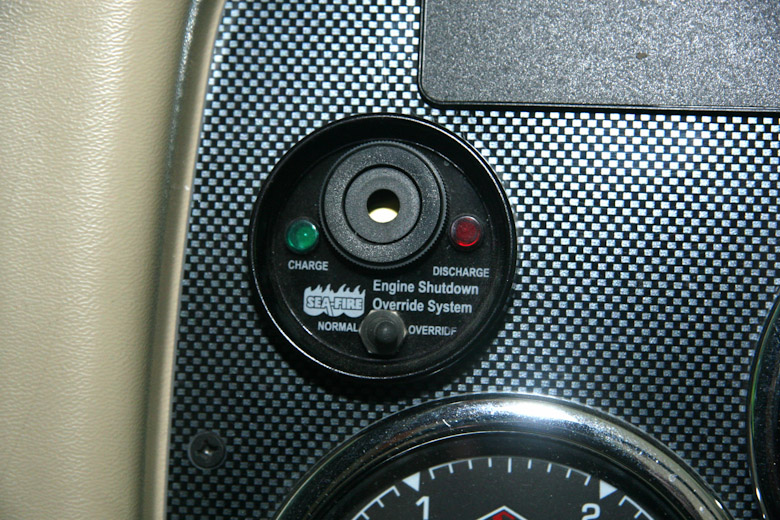
A remote alarm display was mounted in the instrument panel to alert me in the event
the extinguisher deployed.
|
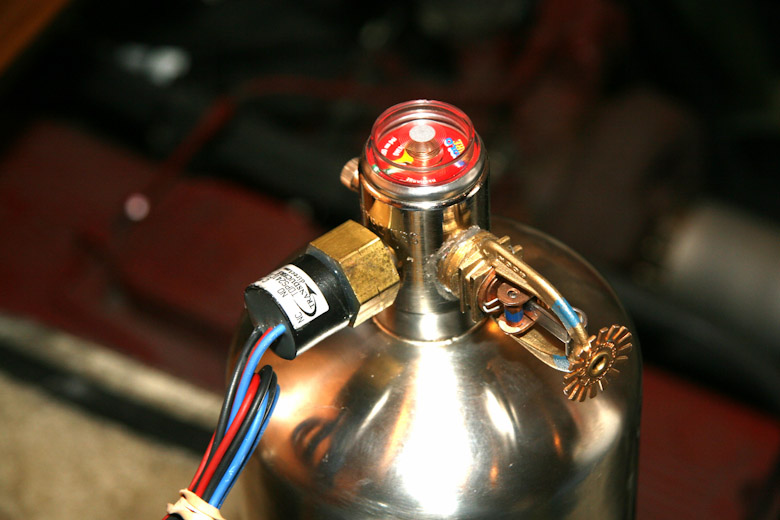
A pressure sensor attached to the bottle was used to activate the alarm if the pressure dropped.
|
The existing dry chemical ABC extinguisher was too small and also ineffective in fighting any Class-A fires. The
Cold Fire system technically wasn't rated for Class-C electrical fires, but the fine nozzle spray from these hand-held units did allow
for safe use on an energized circuit.
I began by installing the Cold Fire bottle in the engine bay. The spray head had a 10-foot range, so I mounted it
horizontally so that the spray would rain down from the top of the engine compartment and give me complete coverage. There was plenty of
room in the engine compartment, so I used the larger 4-liter bottle, which gave me maximum run time.
I removed the mounting bracket from the bottle and drilled the mounting holes out to a larger size so I could use
bolts rather than screws to mount the container. It would be mounted underneath the floor, so I didn't want it falling off because some
screws pulled out.
|
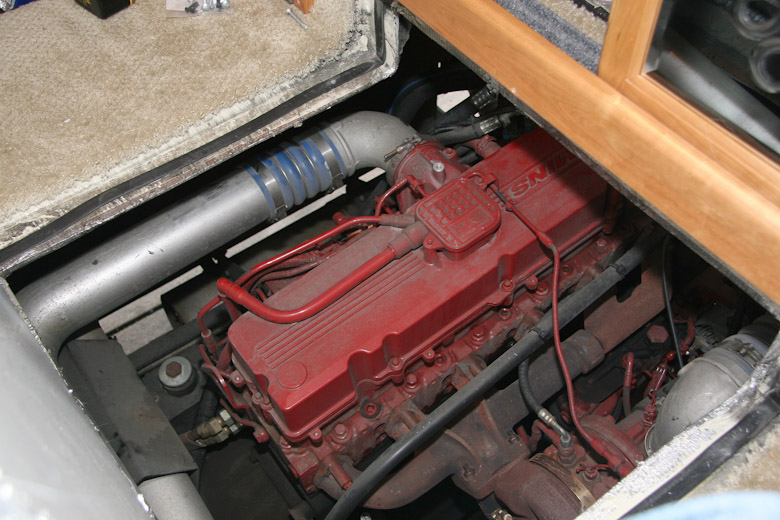
The engine access panel in the bedroom floor was removed to allow access to the engine compartment.
|
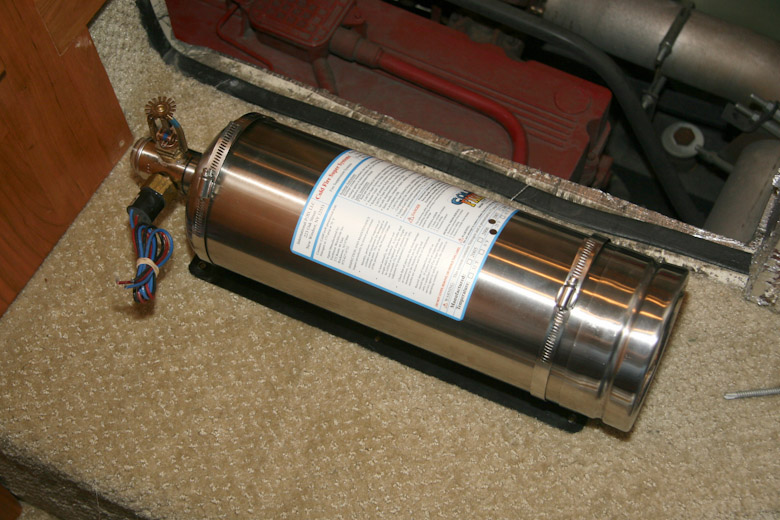
The ColdFire bottle and mounting bracket was just the right size for our application.
|
I then oriented the tank so that I could easily see the pressure gauge from the rear of the coach when the engine
bay access doors were open. I then ran a pair of #16 wires from the container's pressure sensor switch up to the dash area where I would
install my alarm.
It wouldn't be hard to build an alarm system from scratch. All you would need would be a warning light, a relay,
and an audible horn or buzzer. But I found a Sea-Fire alarm system online at Go2Marine that was perfect for this application. I drilled
a 2-inch-diameter hole in my motorhome's dash and installed the alarm module. I then wired it up to 12-volt power and ground and
connected the two wires to the low-pressure sensor switch.
The end result is that I'm now adequately protected against any small fires that begin inside the coach. With one
extinguisher up front and one in the bedroom, I stand a fair chance at extinguishing the fire before it gets out of hand. The engine
compartment is also protected.
Should the unthinkable happen, the Cold Fire system would deploy and instantly warn me. In a best-case scenario,
it will extinguish the fire. If the automatic system can't put it out, it will at least give me enough time to pull over, shut down, and
attack it with a handheld. In a worst-case scenario, I've at least been given enough warning and bought a bit more time to safely
evacuate the RV.
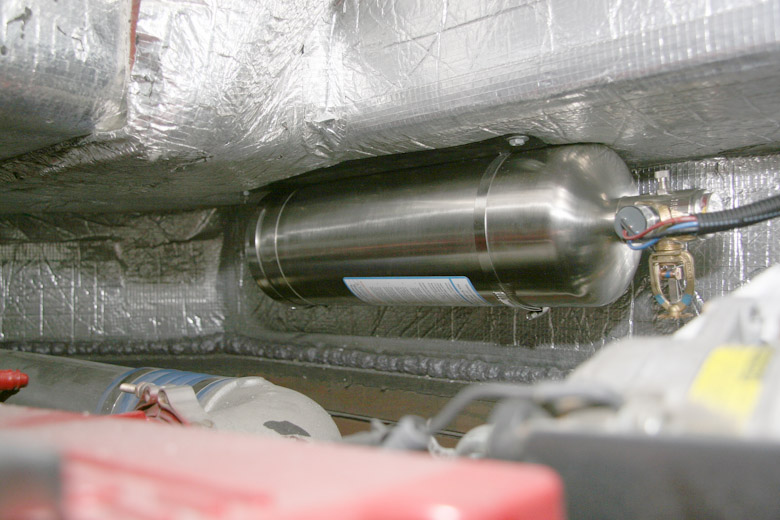
The Cold Fire extinguisher was mounted at the top of the engine compartment, ready to deploy should it
ever be needed.
Sources
Cold Fire Super Systems
(845) 641-7285
www.coldfiresupersystems.com
Mac The Fire Guy
(503) 559-7623
www.macthefireguy.com
Sea-Fire Marine
(410) 687-5500
www.sea-fire.com
Return to Home Page
If you enjoyed this article be sure to recommend RVtechMag.com to your friends, like us on Facebook or Twitter
or subscribe to our RSS feed.



|















